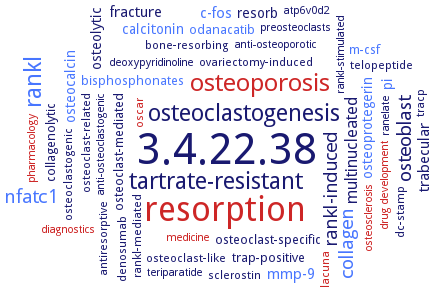3.4.22.38: cathepsin K
This is an abbreviated version!
For detailed information about cathepsin K, go to the full flat file.

Word Map on EC 3.4.22.38 
-
3.4.22.38
-
resorption
-
osteoporosis
-
osteoclastogenesis
-
rankl
-
tartrate-resistant
-
osteoblast
-
collagen
-
nfatc1
-
rankl-induced
-
multinucleated
-
mmp-9
-
c-fos
-
fracture
-
trabecular
-
pi
-
calcitonin
-
osteocalcin
-
osteoprotegerin
-
osteolytic
-
resorb
-
m-csf
-
collagenolytic
-
bisphosphonates
-
osteoclast-mediated
-
trap-positive
-
osteoclast-specific
-
odanacatib
-
oscar
-
antiresorptive
-
tracp
-
lacuna
-
ovariectomy-induced
-
rankl-mediated
-
dc-stamp
-
bone-resorbing
-
sclerostin
-
osteoclast-related
-
telopeptide
-
osteoclast-like
-
osteoclastogenic
-
denosumab
-
preosteoclasts
-
teriparatide
-
pharmacology
-
anti-osteoclastogenic
-
osteosclerosis
-
anti-osteoporotic
-
atp6v0d2
-
medicine
-
ranelate
-
drug development
-
deoxypyridinoline
-
rankl-stimulated
-
diagnostics
- 3.4.22.38
- resorption
- osteoporosis
-
osteoclastogenesis
- rankl
-
tartrate-resistant
- osteoblast
- collagen
- nfatc1
-
rankl-induced
-
multinucleated
- mmp-9
- c-fos
-
fracture
-
trabecular
- pi
- calcitonin
- osteocalcin
- osteoprotegerin
-
osteolytic
-
resorb
- m-csf
-
collagenolytic
- bisphosphonates
-
osteoclast-mediated
-
trap-positive
-
osteoclast-specific
- odanacatib
- oscar
-
antiresorptive
- tracp
- lacuna
-
ovariectomy-induced
-
rankl-mediated
-
dc-stamp
-
bone-resorbing
-
sclerostin
-
osteoclast-related
-
telopeptide
-
osteoclast-like
-
osteoclastogenic
-
denosumab
-
preosteoclasts
-
teriparatide
- pharmacology
-
anti-osteoclastogenic
- osteosclerosis
-
anti-osteoporotic
- atp6v0d2
- medicine
-
ranelate
- drug development
-
deoxypyridinoline
-
rankl-stimulated
- diagnostics
Reaction
Broad proteolytic activity. With small-molecule substrates and inhibitors, the major determinant of specificity is P2, which is preferably Leu, Met > Phe, and not Arg =
Synonyms
Cat K, Cat-K, cath K, cathepsin K, cathepsin O, Cathepsin O2, cathepsin-K, catK, Ctk, CTSK, Human osteoclast cathepsin K, More, OC-2 protein, rhCK
ECTree
Advanced search results
Crystallization
Crystallization on EC 3.4.22.38 - cathepsin K
Please wait a moment until all data is loaded. This message will disappear when all data is loaded.
crystal structure of enzyme-inhibitor complex, inhibitor: N-[1S-(2-phenylethyl)-3-phenylsulfonylallyl]-4-methyl-2R-piperazinyl carbonylaminovaleramide, i.e. APC3328
-
in complex with NSC13345, sitting drop vapor diffusion method, using 0.2 M ammonium sulfate, pH 5.5, 30% (w/v) PEG-8000
mutant K9E/I171E/Q172S/N190M/K191G/L195K (E-64 inhibited) in complex with the 17000 Da fraction of chondroitin 4-sulfate, hanging drop vapor diffusion method, using 30% (v/v) 2-methyl-2,4-pentanediol, 0.1 M sodium acetate buffer, pH 4.5, and 20 mM CaCl2
purified and activated, recombinant cathepsin K in complex with chondroitin sulfate in presence or absence of inhibitor E64, which prevents autocatalytic cleavage of cathepsin K, 25 mg/ml enzyme-inhibitor complex of ratio 1:1 in 50 mM sodium acetate buffer, pH 5.5, hanging drop vapor diffusion method, mixing with an equal volume of reservoir solution containing 30% v/v 2-methyl-2,4-pentanediol, 0.1 M sodium acetate buffer, pH 4.5, and 20 mM calcium chloride, macroseeding, X-ray diffraction structure determination and analysis at 1.8 A resolution
-
the overall organization of the catalytic site, which consists of two domains folds together to give a V-shaped active site cleft configuration. The central helix is the most prominent feature of the left domain, whereas the right domain is mostly dominated by beta-barrel motifs (5-6 strands). The active site lies at the interface between the two domains
-
crysallized from 20% MPD, 0.1 M Tris, pH 7 and 0.1 M MES, pH 6, crystals were flash frozen in a nitrogen stream after increasing the MPD concentration to aproximately 30%
-


 results (
results ( results (
results ( top
top





